Public Health Policy and Practice: A Review
VerifiedAdded on 2021/04/21
|15
|4044
|99
AI Summary
This assignment provides a comprehensive review of public health policy and practice. It includes a discussion of the contribution of other sexually transmitted diseases to sexual transmission of HIV infection, as well as an analysis of the politics and organization of the National Health Service (NHS) in Britain. The assignment also explores the critical role of capacity-building within health promotion programs, and examines the perspectives of health policy-makers on their use of evidence. Additionally, it reviews the regulation of America and Sweden's occupational safety and health policies, and discusses the importance of social inequalities in health for new evidence and policy implications.
Contribute Materials
Your contribution can guide someone’s learning journey. Share your
documents today.
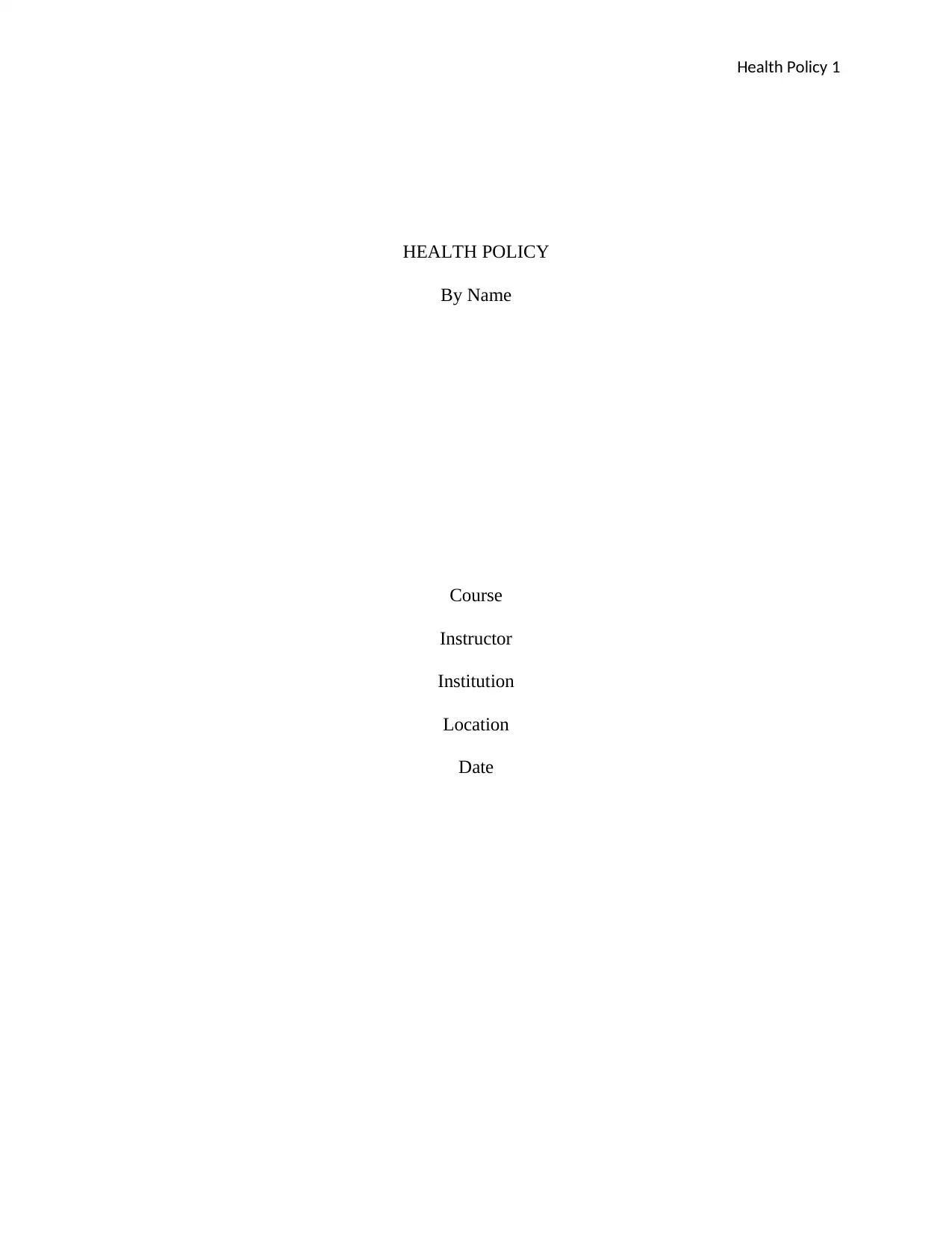
Health Policy 1
HEALTH POLICY
By Name
Course
Instructor
Institution
Location
Date
HEALTH POLICY
By Name
Course
Instructor
Institution
Location
Date
Secure Best Marks with AI Grader
Need help grading? Try our AI Grader for instant feedback on your assignments.

Health Policy 2
Abstract
Development of antibiotic resistance is progressively growing to become a worldwide
challenge ineffective efforts of preventing and treating of diseases causing infections. The
intensity of the consequences of the antibiotic resistance is most frequent in world developing
countries with the excessive and improper use of self-medication of antibiotics forming a major
factor. In long end, available treatments become less effective and of limited assistance to the
patient as it encourages persistence and spreading of the infection to other healthy people
(Murray & Lopez, 2016).
With an aim of reducing these impacts, this policy through collaboration with the
Pakistan government, non-governmental organization and institutions ministry of health and the
entire health system needs to jointly come up with long a term solution in managing the highly
growing development of drug resistance. The strategies to be adopted should be channeled
towards regulating and discouraging the consumption of over the counter drugs which lacks
professional prescription. This will eventually reduce the accessibility of the citizens particularly
the rural settlement to the mention self-medication (Reich, 2015).
Abstract
Development of antibiotic resistance is progressively growing to become a worldwide
challenge ineffective efforts of preventing and treating of diseases causing infections. The
intensity of the consequences of the antibiotic resistance is most frequent in world developing
countries with the excessive and improper use of self-medication of antibiotics forming a major
factor. In long end, available treatments become less effective and of limited assistance to the
patient as it encourages persistence and spreading of the infection to other healthy people
(Murray & Lopez, 2016).
With an aim of reducing these impacts, this policy through collaboration with the
Pakistan government, non-governmental organization and institutions ministry of health and the
entire health system needs to jointly come up with long a term solution in managing the highly
growing development of drug resistance. The strategies to be adopted should be channeled
towards regulating and discouraging the consumption of over the counter drugs which lacks
professional prescription. This will eventually reduce the accessibility of the citizens particularly
the rural settlement to the mention self-medication (Reich, 2015).
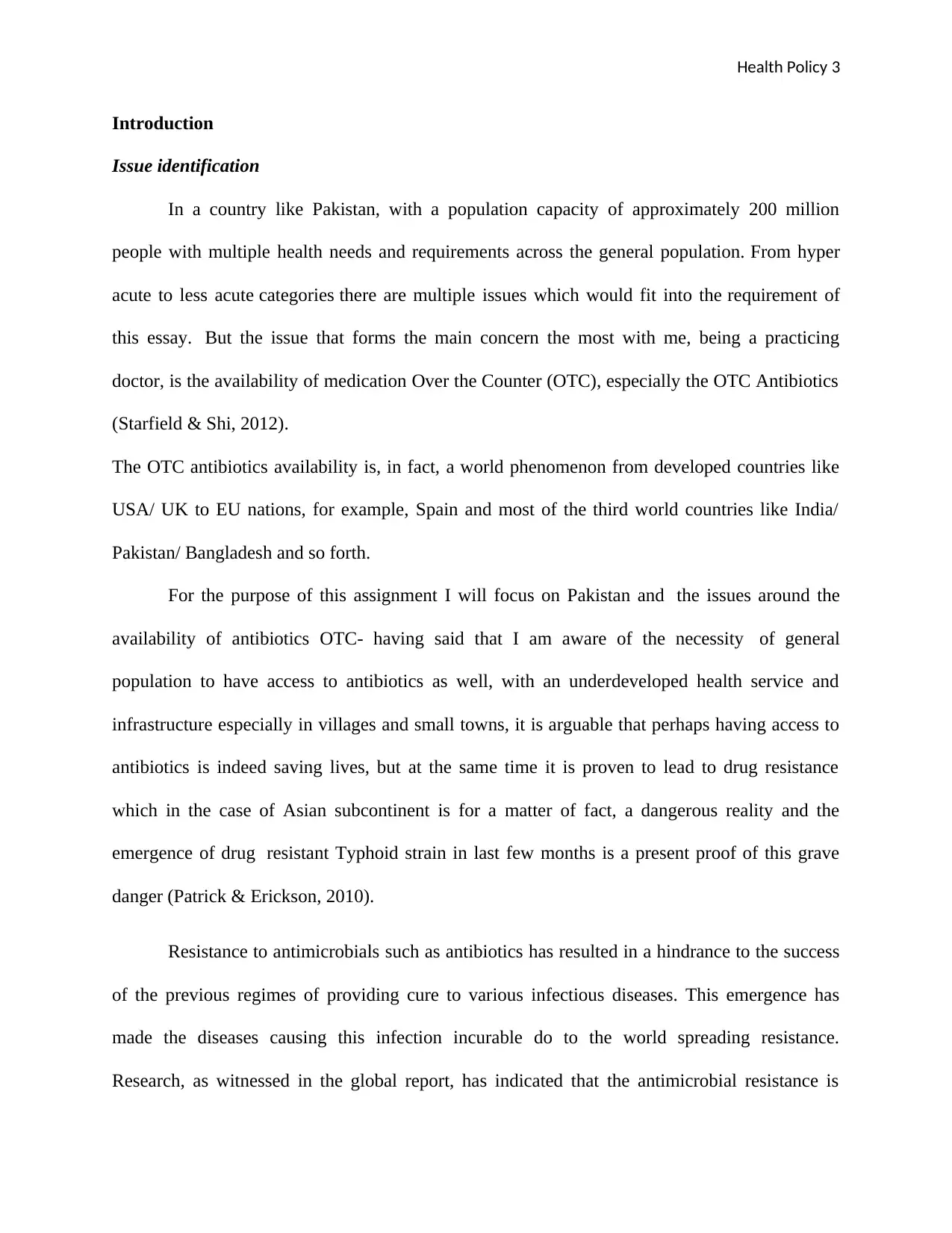
Health Policy 3
Introduction
Issue identification
In a country like Pakistan, with a population capacity of approximately 200 million
people with multiple health needs and requirements across the general population. From hyper
acute to less acute categories there are multiple issues which would fit into the requirement of
this essay. But the issue that forms the main concern the most with me, being a practicing
doctor, is the availability of medication Over the Counter (OTC), especially the OTC Antibiotics
(Starfield & Shi, 2012).
The OTC antibiotics availability is, in fact, a world phenomenon from developed countries like
USA/ UK to EU nations, for example, Spain and most of the third world countries like India/
Pakistan/ Bangladesh and so forth.
For the purpose of this assignment I will focus on Pakistan and the issues around the
availability of antibiotics OTC- having said that I am aware of the necessity of general
population to have access to antibiotics as well, with an underdeveloped health service and
infrastructure especially in villages and small towns, it is arguable that perhaps having access to
antibiotics is indeed saving lives, but at the same time it is proven to lead to drug resistance
which in the case of Asian subcontinent is for a matter of fact, a dangerous reality and the
emergence of drug resistant Typhoid strain in last few months is a present proof of this grave
danger (Patrick & Erickson, 2010).
Resistance to antimicrobials such as antibiotics has resulted in a hindrance to the success
of the previous regimes of providing cure to various infectious diseases. This emergence has
made the diseases causing this infection incurable do to the world spreading resistance.
Research, as witnessed in the global report, has indicated that the antimicrobial resistance is
Introduction
Issue identification
In a country like Pakistan, with a population capacity of approximately 200 million
people with multiple health needs and requirements across the general population. From hyper
acute to less acute categories there are multiple issues which would fit into the requirement of
this essay. But the issue that forms the main concern the most with me, being a practicing
doctor, is the availability of medication Over the Counter (OTC), especially the OTC Antibiotics
(Starfield & Shi, 2012).
The OTC antibiotics availability is, in fact, a world phenomenon from developed countries like
USA/ UK to EU nations, for example, Spain and most of the third world countries like India/
Pakistan/ Bangladesh and so forth.
For the purpose of this assignment I will focus on Pakistan and the issues around the
availability of antibiotics OTC- having said that I am aware of the necessity of general
population to have access to antibiotics as well, with an underdeveloped health service and
infrastructure especially in villages and small towns, it is arguable that perhaps having access to
antibiotics is indeed saving lives, but at the same time it is proven to lead to drug resistance
which in the case of Asian subcontinent is for a matter of fact, a dangerous reality and the
emergence of drug resistant Typhoid strain in last few months is a present proof of this grave
danger (Patrick & Erickson, 2010).
Resistance to antimicrobials such as antibiotics has resulted in a hindrance to the success
of the previous regimes of providing cure to various infectious diseases. This emergence has
made the diseases causing this infection incurable do to the world spreading resistance.
Research, as witnessed in the global report, has indicated that the antimicrobial resistance is
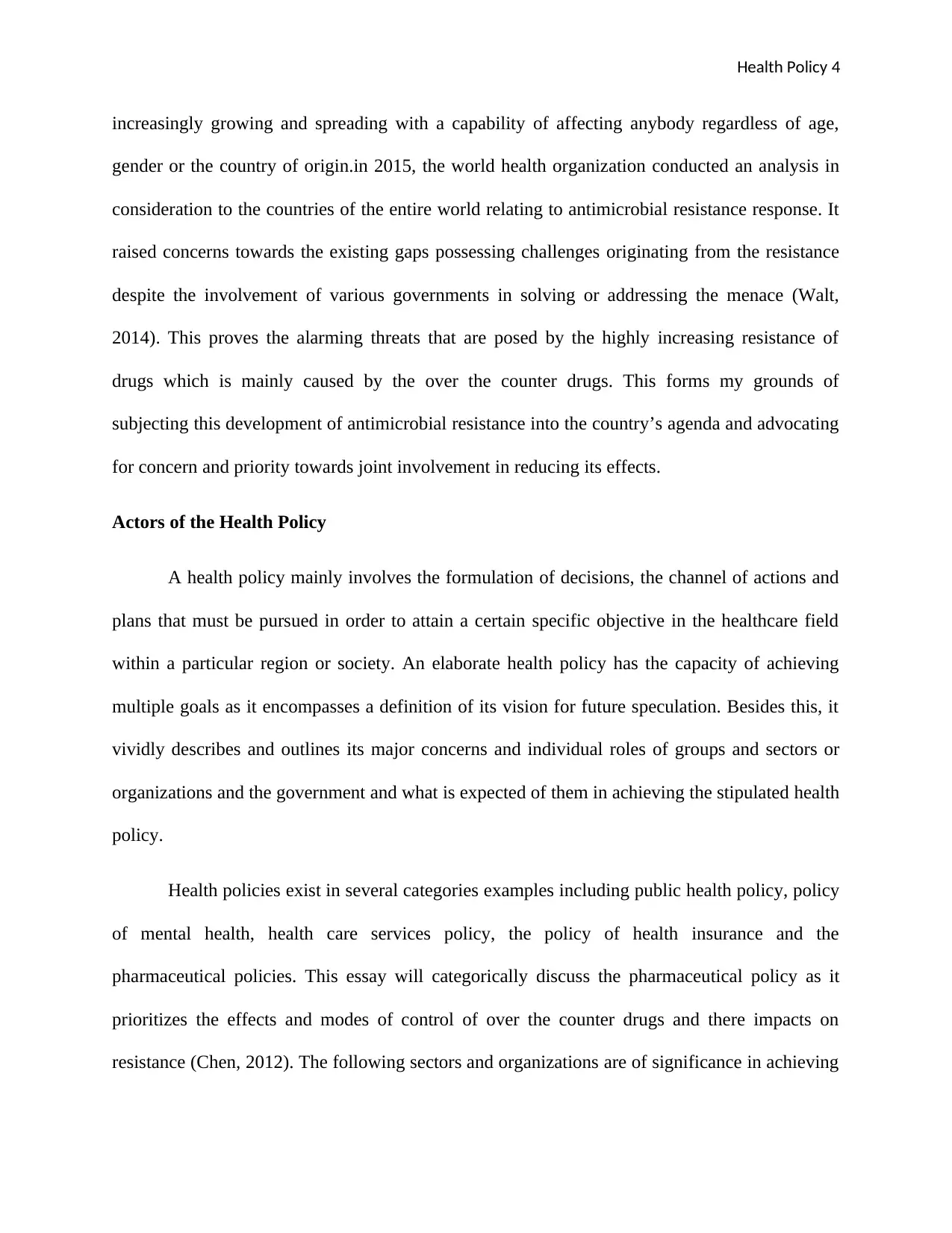
Health Policy 4
increasingly growing and spreading with a capability of affecting anybody regardless of age,
gender or the country of origin.in 2015, the world health organization conducted an analysis in
consideration to the countries of the entire world relating to antimicrobial resistance response. It
raised concerns towards the existing gaps possessing challenges originating from the resistance
despite the involvement of various governments in solving or addressing the menace (Walt,
2014). This proves the alarming threats that are posed by the highly increasing resistance of
drugs which is mainly caused by the over the counter drugs. This forms my grounds of
subjecting this development of antimicrobial resistance into the country’s agenda and advocating
for concern and priority towards joint involvement in reducing its effects.
Actors of the Health Policy
A health policy mainly involves the formulation of decisions, the channel of actions and
plans that must be pursued in order to attain a certain specific objective in the healthcare field
within a particular region or society. An elaborate health policy has the capacity of achieving
multiple goals as it encompasses a definition of its vision for future speculation. Besides this, it
vividly describes and outlines its major concerns and individual roles of groups and sectors or
organizations and the government and what is expected of them in achieving the stipulated health
policy.
Health policies exist in several categories examples including public health policy, policy
of mental health, health care services policy, the policy of health insurance and the
pharmaceutical policies. This essay will categorically discuss the pharmaceutical policy as it
prioritizes the effects and modes of control of over the counter drugs and there impacts on
resistance (Chen, 2012). The following sectors and organizations are of significance in achieving
increasingly growing and spreading with a capability of affecting anybody regardless of age,
gender or the country of origin.in 2015, the world health organization conducted an analysis in
consideration to the countries of the entire world relating to antimicrobial resistance response. It
raised concerns towards the existing gaps possessing challenges originating from the resistance
despite the involvement of various governments in solving or addressing the menace (Walt,
2014). This proves the alarming threats that are posed by the highly increasing resistance of
drugs which is mainly caused by the over the counter drugs. This forms my grounds of
subjecting this development of antimicrobial resistance into the country’s agenda and advocating
for concern and priority towards joint involvement in reducing its effects.
Actors of the Health Policy
A health policy mainly involves the formulation of decisions, the channel of actions and
plans that must be pursued in order to attain a certain specific objective in the healthcare field
within a particular region or society. An elaborate health policy has the capacity of achieving
multiple goals as it encompasses a definition of its vision for future speculation. Besides this, it
vividly describes and outlines its major concerns and individual roles of groups and sectors or
organizations and the government and what is expected of them in achieving the stipulated health
policy.
Health policies exist in several categories examples including public health policy, policy
of mental health, health care services policy, the policy of health insurance and the
pharmaceutical policies. This essay will categorically discuss the pharmaceutical policy as it
prioritizes the effects and modes of control of over the counter drugs and there impacts on
resistance (Chen, 2012). The following sectors and organizations are of significance in achieving
Secure Best Marks with AI Grader
Need help grading? Try our AI Grader for instant feedback on your assignments.
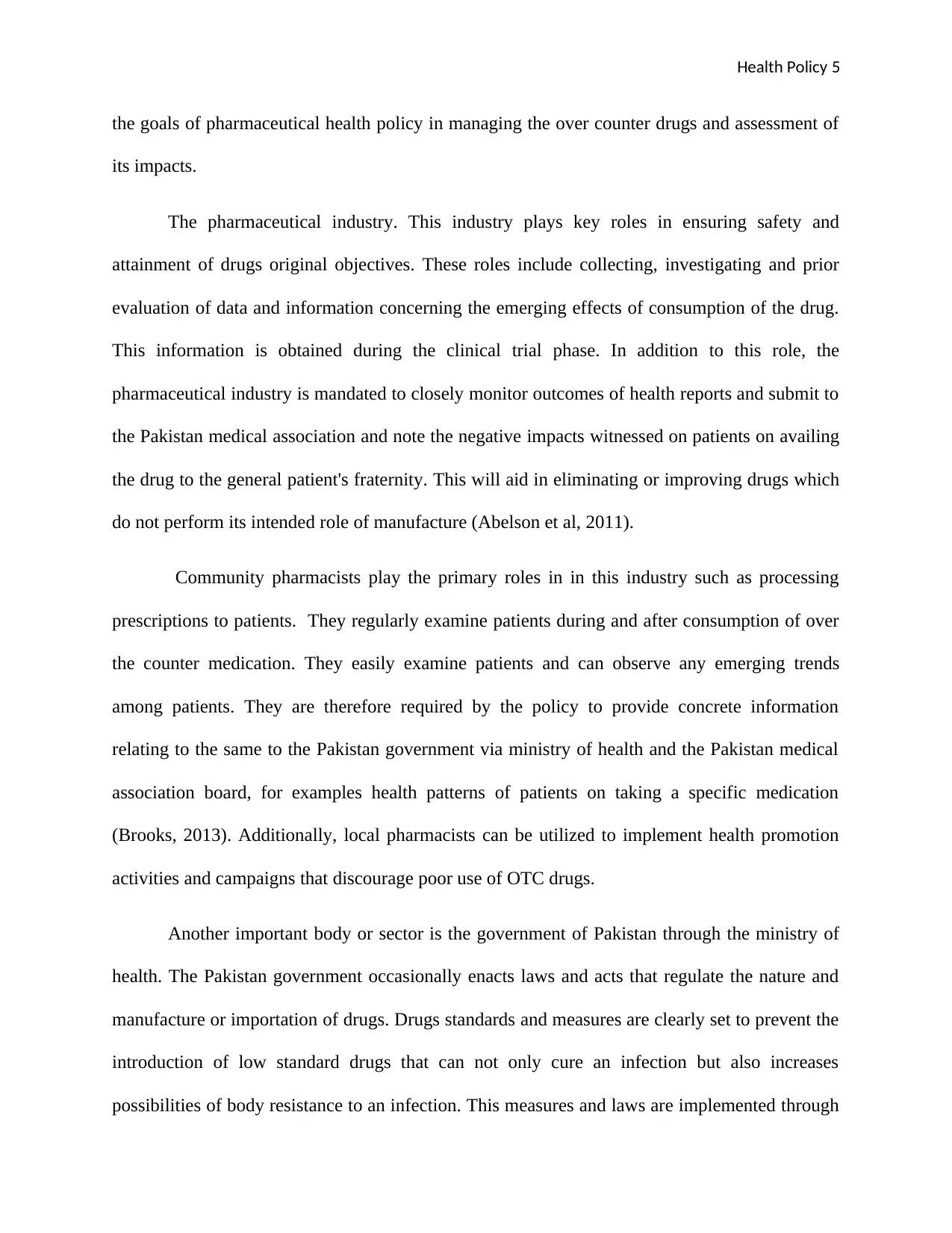
Health Policy 5
the goals of pharmaceutical health policy in managing the over counter drugs and assessment of
its impacts.
The pharmaceutical industry. This industry plays key roles in ensuring safety and
attainment of drugs original objectives. These roles include collecting, investigating and prior
evaluation of data and information concerning the emerging effects of consumption of the drug.
This information is obtained during the clinical trial phase. In addition to this role, the
pharmaceutical industry is mandated to closely monitor outcomes of health reports and submit to
the Pakistan medical association and note the negative impacts witnessed on patients on availing
the drug to the general patient's fraternity. This will aid in eliminating or improving drugs which
do not perform its intended role of manufacture (Abelson et al, 2011).
Community pharmacists play the primary roles in in this industry such as processing
prescriptions to patients. They regularly examine patients during and after consumption of over
the counter medication. They easily examine patients and can observe any emerging trends
among patients. They are therefore required by the policy to provide concrete information
relating to the same to the Pakistan government via ministry of health and the Pakistan medical
association board, for examples health patterns of patients on taking a specific medication
(Brooks, 2013). Additionally, local pharmacists can be utilized to implement health promotion
activities and campaigns that discourage poor use of OTC drugs.
Another important body or sector is the government of Pakistan through the ministry of
health. The Pakistan government occasionally enacts laws and acts that regulate the nature and
manufacture or importation of drugs. Drugs standards and measures are clearly set to prevent the
introduction of low standard drugs that can not only cure an infection but also increases
possibilities of body resistance to an infection. This measures and laws are implemented through
the goals of pharmaceutical health policy in managing the over counter drugs and assessment of
its impacts.
The pharmaceutical industry. This industry plays key roles in ensuring safety and
attainment of drugs original objectives. These roles include collecting, investigating and prior
evaluation of data and information concerning the emerging effects of consumption of the drug.
This information is obtained during the clinical trial phase. In addition to this role, the
pharmaceutical industry is mandated to closely monitor outcomes of health reports and submit to
the Pakistan medical association and note the negative impacts witnessed on patients on availing
the drug to the general patient's fraternity. This will aid in eliminating or improving drugs which
do not perform its intended role of manufacture (Abelson et al, 2011).
Community pharmacists play the primary roles in in this industry such as processing
prescriptions to patients. They regularly examine patients during and after consumption of over
the counter medication. They easily examine patients and can observe any emerging trends
among patients. They are therefore required by the policy to provide concrete information
relating to the same to the Pakistan government via ministry of health and the Pakistan medical
association board, for examples health patterns of patients on taking a specific medication
(Brooks, 2013). Additionally, local pharmacists can be utilized to implement health promotion
activities and campaigns that discourage poor use of OTC drugs.
Another important body or sector is the government of Pakistan through the ministry of
health. The Pakistan government occasionally enacts laws and acts that regulate the nature and
manufacture or importation of drugs. Drugs standards and measures are clearly set to prevent the
introduction of low standard drugs that can not only cure an infection but also increases
possibilities of body resistance to an infection. This measures and laws are implemented through
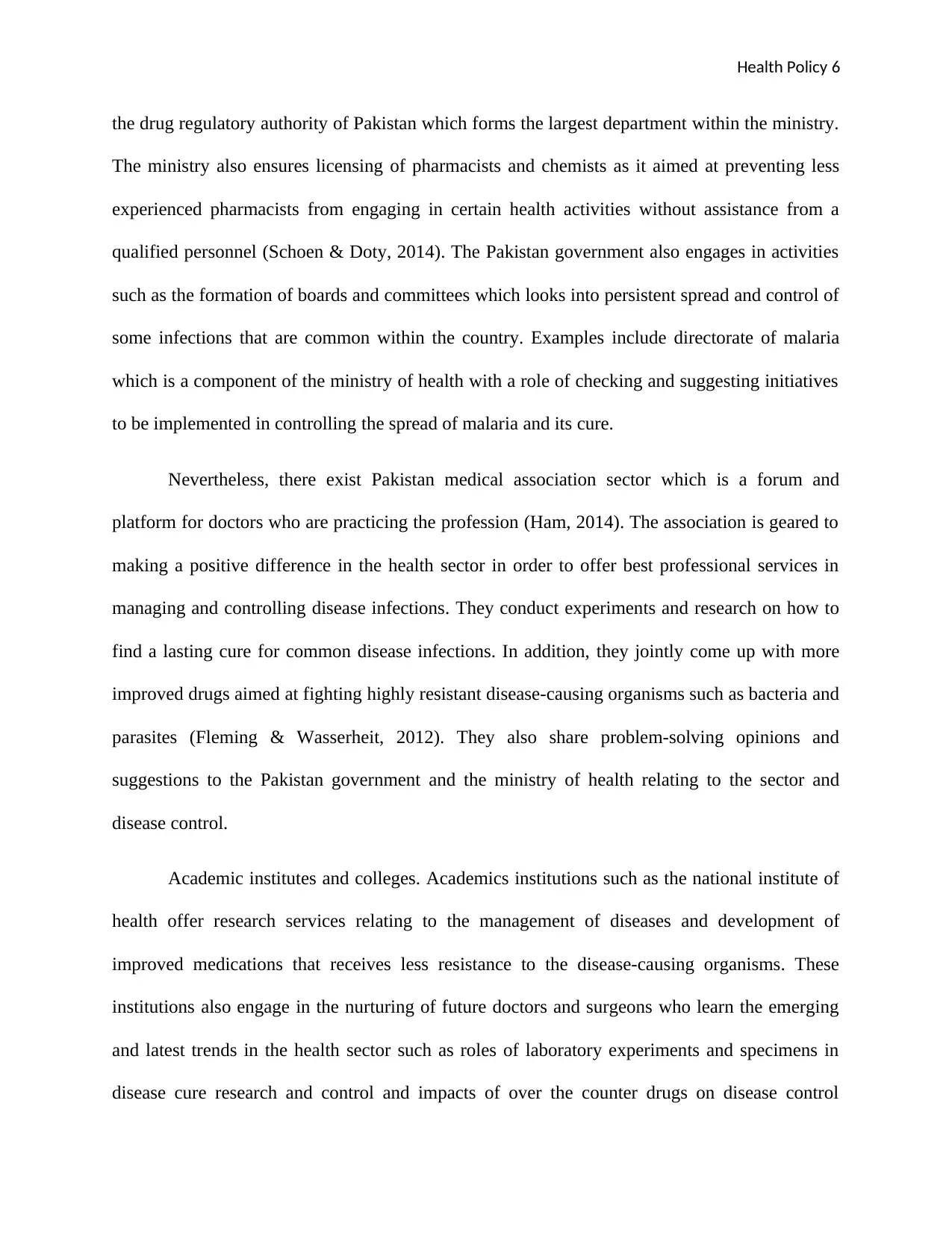
Health Policy 6
the drug regulatory authority of Pakistan which forms the largest department within the ministry.
The ministry also ensures licensing of pharmacists and chemists as it aimed at preventing less
experienced pharmacists from engaging in certain health activities without assistance from a
qualified personnel (Schoen & Doty, 2014). The Pakistan government also engages in activities
such as the formation of boards and committees which looks into persistent spread and control of
some infections that are common within the country. Examples include directorate of malaria
which is a component of the ministry of health with a role of checking and suggesting initiatives
to be implemented in controlling the spread of malaria and its cure.
Nevertheless, there exist Pakistan medical association sector which is a forum and
platform for doctors who are practicing the profession (Ham, 2014). The association is geared to
making a positive difference in the health sector in order to offer best professional services in
managing and controlling disease infections. They conduct experiments and research on how to
find a lasting cure for common disease infections. In addition, they jointly come up with more
improved drugs aimed at fighting highly resistant disease-causing organisms such as bacteria and
parasites (Fleming & Wasserheit, 2012). They also share problem-solving opinions and
suggestions to the Pakistan government and the ministry of health relating to the sector and
disease control.
Academic institutes and colleges. Academics institutions such as the national institute of
health offer research services relating to the management of diseases and development of
improved medications that receives less resistance to the disease-causing organisms. These
institutions also engage in the nurturing of future doctors and surgeons who learn the emerging
and latest trends in the health sector such as roles of laboratory experiments and specimens in
disease cure research and control and impacts of over the counter drugs on disease control
the drug regulatory authority of Pakistan which forms the largest department within the ministry.
The ministry also ensures licensing of pharmacists and chemists as it aimed at preventing less
experienced pharmacists from engaging in certain health activities without assistance from a
qualified personnel (Schoen & Doty, 2014). The Pakistan government also engages in activities
such as the formation of boards and committees which looks into persistent spread and control of
some infections that are common within the country. Examples include directorate of malaria
which is a component of the ministry of health with a role of checking and suggesting initiatives
to be implemented in controlling the spread of malaria and its cure.
Nevertheless, there exist Pakistan medical association sector which is a forum and
platform for doctors who are practicing the profession (Ham, 2014). The association is geared to
making a positive difference in the health sector in order to offer best professional services in
managing and controlling disease infections. They conduct experiments and research on how to
find a lasting cure for common disease infections. In addition, they jointly come up with more
improved drugs aimed at fighting highly resistant disease-causing organisms such as bacteria and
parasites (Fleming & Wasserheit, 2012). They also share problem-solving opinions and
suggestions to the Pakistan government and the ministry of health relating to the sector and
disease control.
Academic institutes and colleges. Academics institutions such as the national institute of
health offer research services relating to the management of diseases and development of
improved medications that receives less resistance to the disease-causing organisms. These
institutions also engage in the nurturing of future doctors and surgeons who learn the emerging
and latest trends in the health sector such as roles of laboratory experiments and specimens in
disease cure research and control and impacts of over the counter drugs on disease control
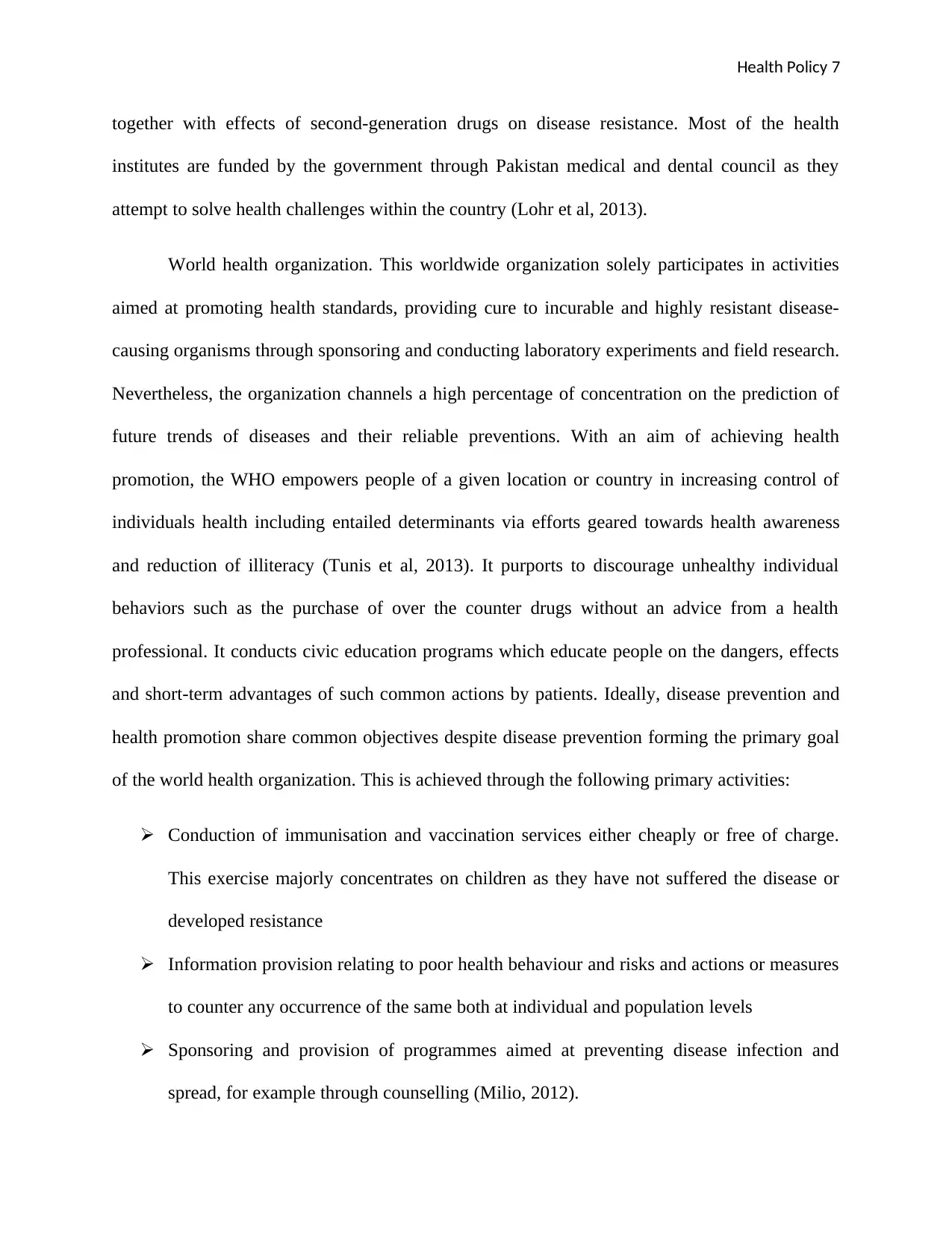
Health Policy 7
together with effects of second-generation drugs on disease resistance. Most of the health
institutes are funded by the government through Pakistan medical and dental council as they
attempt to solve health challenges within the country (Lohr et al, 2013).
World health organization. This worldwide organization solely participates in activities
aimed at promoting health standards, providing cure to incurable and highly resistant disease-
causing organisms through sponsoring and conducting laboratory experiments and field research.
Nevertheless, the organization channels a high percentage of concentration on the prediction of
future trends of diseases and their reliable preventions. With an aim of achieving health
promotion, the WHO empowers people of a given location or country in increasing control of
individuals health including entailed determinants via efforts geared towards health awareness
and reduction of illiteracy (Tunis et al, 2013). It purports to discourage unhealthy individual
behaviors such as the purchase of over the counter drugs without an advice from a health
professional. It conducts civic education programs which educate people on the dangers, effects
and short-term advantages of such common actions by patients. Ideally, disease prevention and
health promotion share common objectives despite disease prevention forming the primary goal
of the world health organization. This is achieved through the following primary activities:
Conduction of immunisation and vaccination services either cheaply or free of charge.
This exercise majorly concentrates on children as they have not suffered the disease or
developed resistance
Information provision relating to poor health behaviour and risks and actions or measures
to counter any occurrence of the same both at individual and population levels
Sponsoring and provision of programmes aimed at preventing disease infection and
spread, for example through counselling (Milio, 2012).
together with effects of second-generation drugs on disease resistance. Most of the health
institutes are funded by the government through Pakistan medical and dental council as they
attempt to solve health challenges within the country (Lohr et al, 2013).
World health organization. This worldwide organization solely participates in activities
aimed at promoting health standards, providing cure to incurable and highly resistant disease-
causing organisms through sponsoring and conducting laboratory experiments and field research.
Nevertheless, the organization channels a high percentage of concentration on the prediction of
future trends of diseases and their reliable preventions. With an aim of achieving health
promotion, the WHO empowers people of a given location or country in increasing control of
individuals health including entailed determinants via efforts geared towards health awareness
and reduction of illiteracy (Tunis et al, 2013). It purports to discourage unhealthy individual
behaviors such as the purchase of over the counter drugs without an advice from a health
professional. It conducts civic education programs which educate people on the dangers, effects
and short-term advantages of such common actions by patients. Ideally, disease prevention and
health promotion share common objectives despite disease prevention forming the primary goal
of the world health organization. This is achieved through the following primary activities:
Conduction of immunisation and vaccination services either cheaply or free of charge.
This exercise majorly concentrates on children as they have not suffered the disease or
developed resistance
Information provision relating to poor health behaviour and risks and actions or measures
to counter any occurrence of the same both at individual and population levels
Sponsoring and provision of programmes aimed at preventing disease infection and
spread, for example through counselling (Milio, 2012).
Paraphrase This Document
Need a fresh take? Get an instant paraphrase of this document with our AI Paraphraser
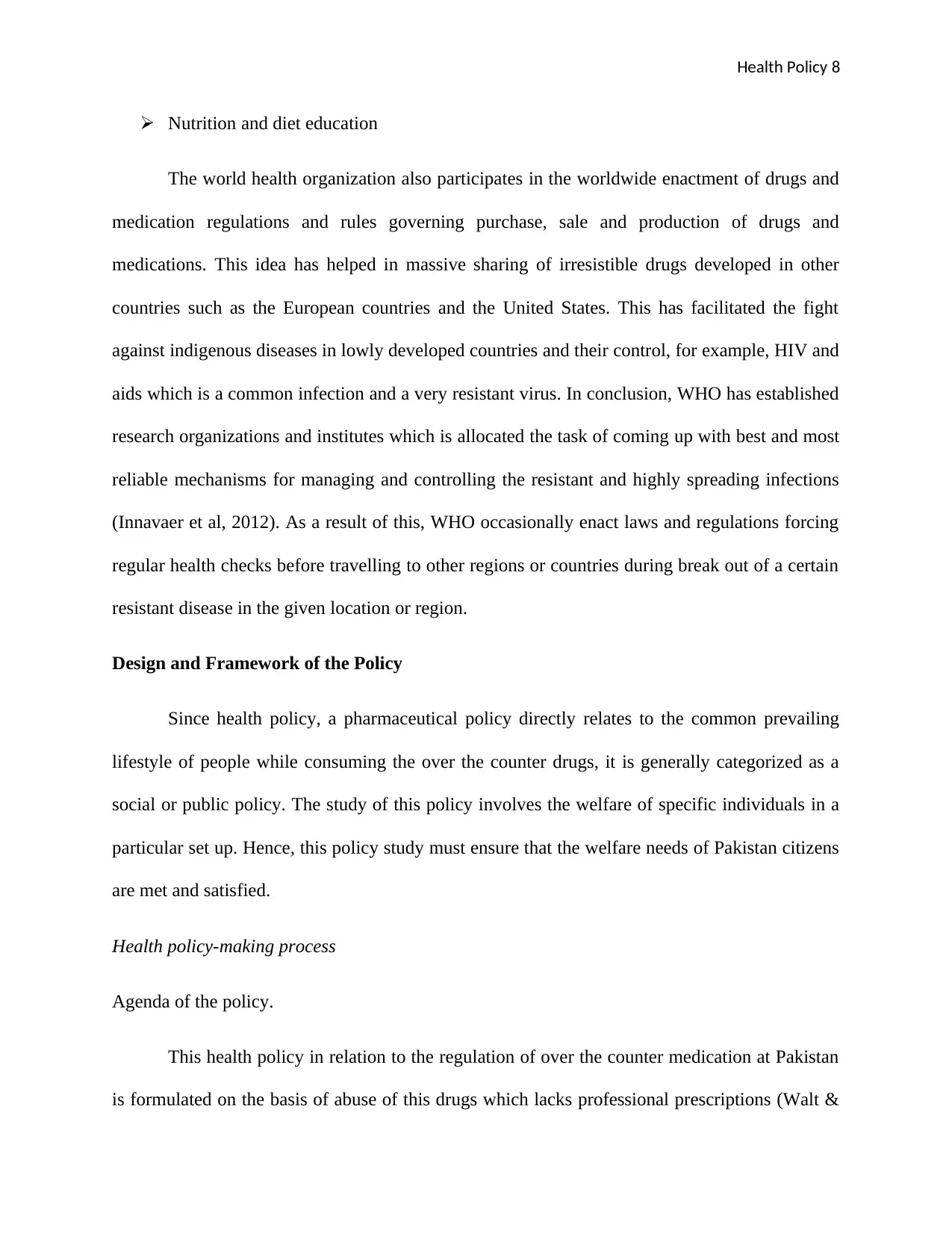
Health Policy 8
Nutrition and diet education
The world health organization also participates in the worldwide enactment of drugs and
medication regulations and rules governing purchase, sale and production of drugs and
medications. This idea has helped in massive sharing of irresistible drugs developed in other
countries such as the European countries and the United States. This has facilitated the fight
against indigenous diseases in lowly developed countries and their control, for example, HIV and
aids which is a common infection and a very resistant virus. In conclusion, WHO has established
research organizations and institutes which is allocated the task of coming up with best and most
reliable mechanisms for managing and controlling the resistant and highly spreading infections
(Innavaer et al, 2012). As a result of this, WHO occasionally enact laws and regulations forcing
regular health checks before travelling to other regions or countries during break out of a certain
resistant disease in the given location or region.
Design and Framework of the Policy
Since health policy, a pharmaceutical policy directly relates to the common prevailing
lifestyle of people while consuming the over the counter drugs, it is generally categorized as a
social or public policy. The study of this policy involves the welfare of specific individuals in a
particular set up. Hence, this policy study must ensure that the welfare needs of Pakistan citizens
are met and satisfied.
Health policy-making process
Agenda of the policy.
This health policy in relation to the regulation of over the counter medication at Pakistan
is formulated on the basis of abuse of this drugs which lacks professional prescriptions (Walt &
Nutrition and diet education
The world health organization also participates in the worldwide enactment of drugs and
medication regulations and rules governing purchase, sale and production of drugs and
medications. This idea has helped in massive sharing of irresistible drugs developed in other
countries such as the European countries and the United States. This has facilitated the fight
against indigenous diseases in lowly developed countries and their control, for example, HIV and
aids which is a common infection and a very resistant virus. In conclusion, WHO has established
research organizations and institutes which is allocated the task of coming up with best and most
reliable mechanisms for managing and controlling the resistant and highly spreading infections
(Innavaer et al, 2012). As a result of this, WHO occasionally enact laws and regulations forcing
regular health checks before travelling to other regions or countries during break out of a certain
resistant disease in the given location or region.
Design and Framework of the Policy
Since health policy, a pharmaceutical policy directly relates to the common prevailing
lifestyle of people while consuming the over the counter drugs, it is generally categorized as a
social or public policy. The study of this policy involves the welfare of specific individuals in a
particular set up. Hence, this policy study must ensure that the welfare needs of Pakistan citizens
are met and satisfied.
Health policy-making process
Agenda of the policy.
This health policy in relation to the regulation of over the counter medication at Pakistan
is formulated on the basis of abuse of this drugs which lacks professional prescriptions (Walt &
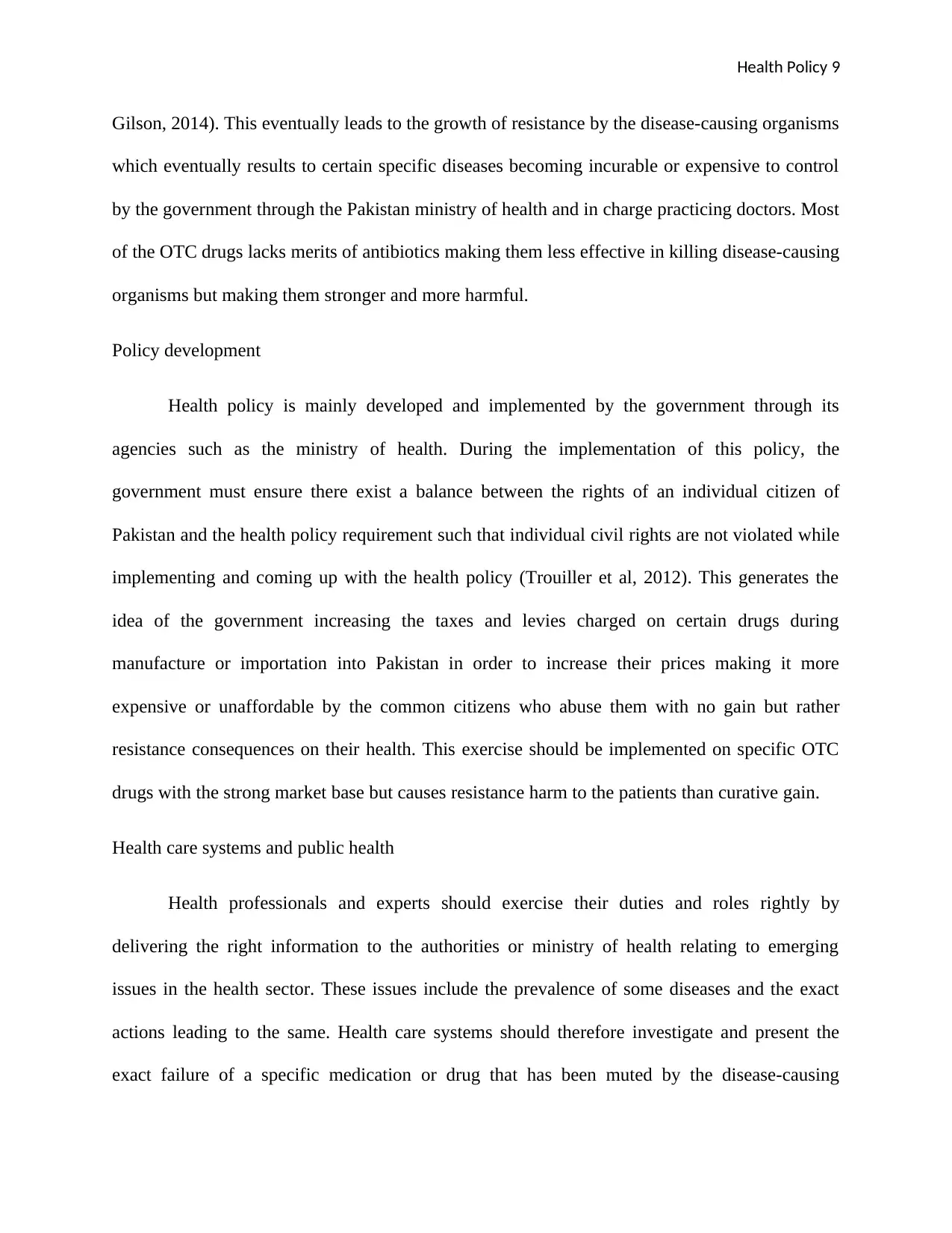
Health Policy 9
Gilson, 2014). This eventually leads to the growth of resistance by the disease-causing organisms
which eventually results to certain specific diseases becoming incurable or expensive to control
by the government through the Pakistan ministry of health and in charge practicing doctors. Most
of the OTC drugs lacks merits of antibiotics making them less effective in killing disease-causing
organisms but making them stronger and more harmful.
Policy development
Health policy is mainly developed and implemented by the government through its
agencies such as the ministry of health. During the implementation of this policy, the
government must ensure there exist a balance between the rights of an individual citizen of
Pakistan and the health policy requirement such that individual civil rights are not violated while
implementing and coming up with the health policy (Trouiller et al, 2012). This generates the
idea of the government increasing the taxes and levies charged on certain drugs during
manufacture or importation into Pakistan in order to increase their prices making it more
expensive or unaffordable by the common citizens who abuse them with no gain but rather
resistance consequences on their health. This exercise should be implemented on specific OTC
drugs with the strong market base but causes resistance harm to the patients than curative gain.
Health care systems and public health
Health professionals and experts should exercise their duties and roles rightly by
delivering the right information to the authorities or ministry of health relating to emerging
issues in the health sector. These issues include the prevalence of some diseases and the exact
actions leading to the same. Health care systems should therefore investigate and present the
exact failure of a specific medication or drug that has been muted by the disease-causing
Gilson, 2014). This eventually leads to the growth of resistance by the disease-causing organisms
which eventually results to certain specific diseases becoming incurable or expensive to control
by the government through the Pakistan ministry of health and in charge practicing doctors. Most
of the OTC drugs lacks merits of antibiotics making them less effective in killing disease-causing
organisms but making them stronger and more harmful.
Policy development
Health policy is mainly developed and implemented by the government through its
agencies such as the ministry of health. During the implementation of this policy, the
government must ensure there exist a balance between the rights of an individual citizen of
Pakistan and the health policy requirement such that individual civil rights are not violated while
implementing and coming up with the health policy (Trouiller et al, 2012). This generates the
idea of the government increasing the taxes and levies charged on certain drugs during
manufacture or importation into Pakistan in order to increase their prices making it more
expensive or unaffordable by the common citizens who abuse them with no gain but rather
resistance consequences on their health. This exercise should be implemented on specific OTC
drugs with the strong market base but causes resistance harm to the patients than curative gain.
Health care systems and public health
Health professionals and experts should exercise their duties and roles rightly by
delivering the right information to the authorities or ministry of health relating to emerging
issues in the health sector. These issues include the prevalence of some diseases and the exact
actions leading to the same. Health care systems should therefore investigate and present the
exact failure of a specific medication or drug that has been muted by the disease-causing
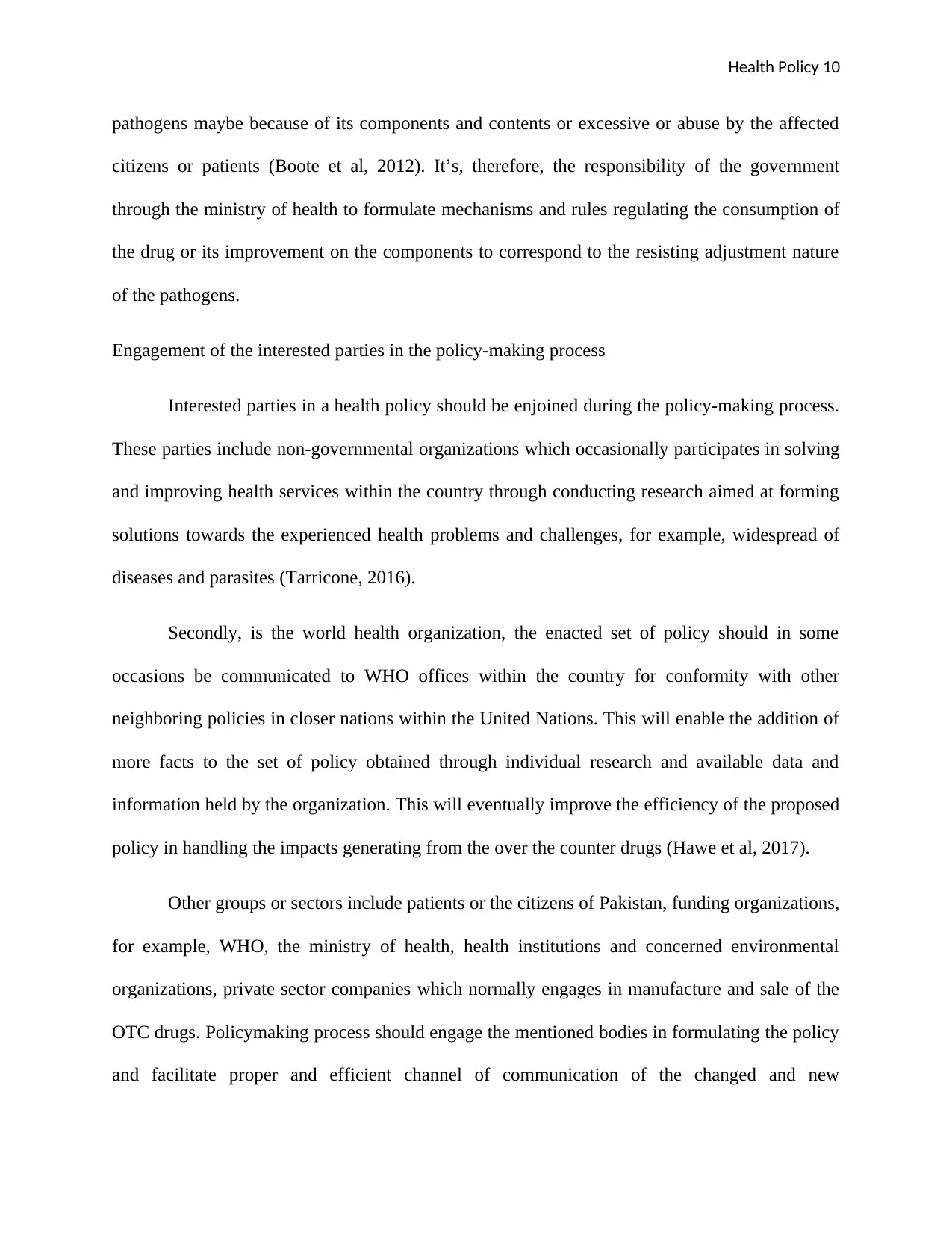
Health Policy 10
pathogens maybe because of its components and contents or excessive or abuse by the affected
citizens or patients (Boote et al, 2012). It’s, therefore, the responsibility of the government
through the ministry of health to formulate mechanisms and rules regulating the consumption of
the drug or its improvement on the components to correspond to the resisting adjustment nature
of the pathogens.
Engagement of the interested parties in the policy-making process
Interested parties in a health policy should be enjoined during the policy-making process.
These parties include non-governmental organizations which occasionally participates in solving
and improving health services within the country through conducting research aimed at forming
solutions towards the experienced health problems and challenges, for example, widespread of
diseases and parasites (Tarricone, 2016).
Secondly, is the world health organization, the enacted set of policy should in some
occasions be communicated to WHO offices within the country for conformity with other
neighboring policies in closer nations within the United Nations. This will enable the addition of
more facts to the set of policy obtained through individual research and available data and
information held by the organization. This will eventually improve the efficiency of the proposed
policy in handling the impacts generating from the over the counter drugs (Hawe et al, 2017).
Other groups or sectors include patients or the citizens of Pakistan, funding organizations,
for example, WHO, the ministry of health, health institutions and concerned environmental
organizations, private sector companies which normally engages in manufacture and sale of the
OTC drugs. Policymaking process should engage the mentioned bodies in formulating the policy
and facilitate proper and efficient channel of communication of the changed and new
pathogens maybe because of its components and contents or excessive or abuse by the affected
citizens or patients (Boote et al, 2012). It’s, therefore, the responsibility of the government
through the ministry of health to formulate mechanisms and rules regulating the consumption of
the drug or its improvement on the components to correspond to the resisting adjustment nature
of the pathogens.
Engagement of the interested parties in the policy-making process
Interested parties in a health policy should be enjoined during the policy-making process.
These parties include non-governmental organizations which occasionally participates in solving
and improving health services within the country through conducting research aimed at forming
solutions towards the experienced health problems and challenges, for example, widespread of
diseases and parasites (Tarricone, 2016).
Secondly, is the world health organization, the enacted set of policy should in some
occasions be communicated to WHO offices within the country for conformity with other
neighboring policies in closer nations within the United Nations. This will enable the addition of
more facts to the set of policy obtained through individual research and available data and
information held by the organization. This will eventually improve the efficiency of the proposed
policy in handling the impacts generating from the over the counter drugs (Hawe et al, 2017).
Other groups or sectors include patients or the citizens of Pakistan, funding organizations,
for example, WHO, the ministry of health, health institutions and concerned environmental
organizations, private sector companies which normally engages in manufacture and sale of the
OTC drugs. Policymaking process should engage the mentioned bodies in formulating the policy
and facilitate proper and efficient channel of communication of the changed and new
Secure Best Marks with AI Grader
Need help grading? Try our AI Grader for instant feedback on your assignments.
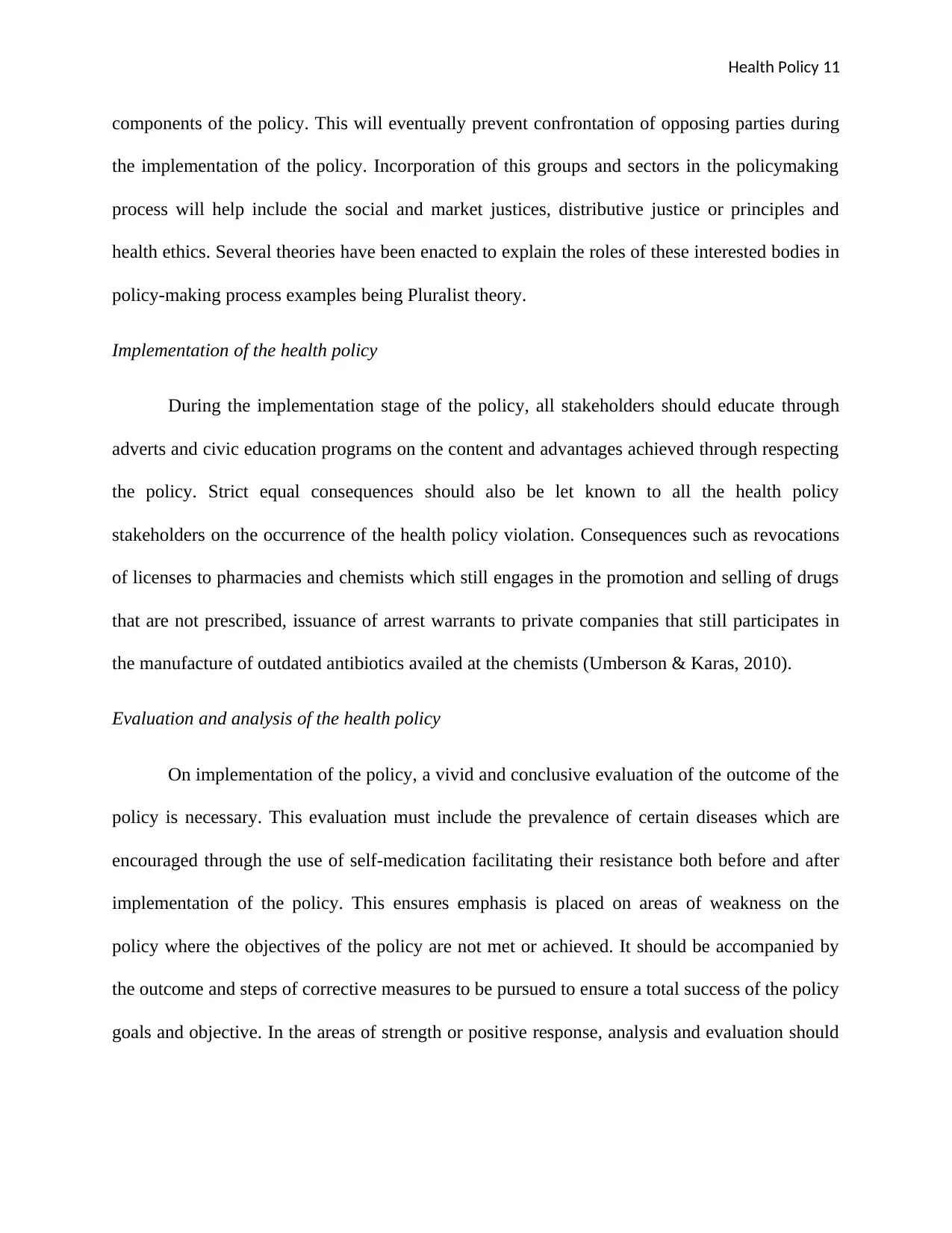
Health Policy 11
components of the policy. This will eventually prevent confrontation of opposing parties during
the implementation of the policy. Incorporation of this groups and sectors in the policymaking
process will help include the social and market justices, distributive justice or principles and
health ethics. Several theories have been enacted to explain the roles of these interested bodies in
policy-making process examples being Pluralist theory.
Implementation of the health policy
During the implementation stage of the policy, all stakeholders should educate through
adverts and civic education programs on the content and advantages achieved through respecting
the policy. Strict equal consequences should also be let known to all the health policy
stakeholders on the occurrence of the health policy violation. Consequences such as revocations
of licenses to pharmacies and chemists which still engages in the promotion and selling of drugs
that are not prescribed, issuance of arrest warrants to private companies that still participates in
the manufacture of outdated antibiotics availed at the chemists (Umberson & Karas, 2010).
Evaluation and analysis of the health policy
On implementation of the policy, a vivid and conclusive evaluation of the outcome of the
policy is necessary. This evaluation must include the prevalence of certain diseases which are
encouraged through the use of self-medication facilitating their resistance both before and after
implementation of the policy. This ensures emphasis is placed on areas of weakness on the
policy where the objectives of the policy are not met or achieved. It should be accompanied by
the outcome and steps of corrective measures to be pursued to ensure a total success of the policy
goals and objective. In the areas of strength or positive response, analysis and evaluation should
components of the policy. This will eventually prevent confrontation of opposing parties during
the implementation of the policy. Incorporation of this groups and sectors in the policymaking
process will help include the social and market justices, distributive justice or principles and
health ethics. Several theories have been enacted to explain the roles of these interested bodies in
policy-making process examples being Pluralist theory.
Implementation of the health policy
During the implementation stage of the policy, all stakeholders should educate through
adverts and civic education programs on the content and advantages achieved through respecting
the policy. Strict equal consequences should also be let known to all the health policy
stakeholders on the occurrence of the health policy violation. Consequences such as revocations
of licenses to pharmacies and chemists which still engages in the promotion and selling of drugs
that are not prescribed, issuance of arrest warrants to private companies that still participates in
the manufacture of outdated antibiotics availed at the chemists (Umberson & Karas, 2010).
Evaluation and analysis of the health policy
On implementation of the policy, a vivid and conclusive evaluation of the outcome of the
policy is necessary. This evaluation must include the prevalence of certain diseases which are
encouraged through the use of self-medication facilitating their resistance both before and after
implementation of the policy. This ensures emphasis is placed on areas of weakness on the
policy where the objectives of the policy are not met or achieved. It should be accompanied by
the outcome and steps of corrective measures to be pursued to ensure a total success of the policy
goals and objective. In the areas of strength or positive response, analysis and evaluation should
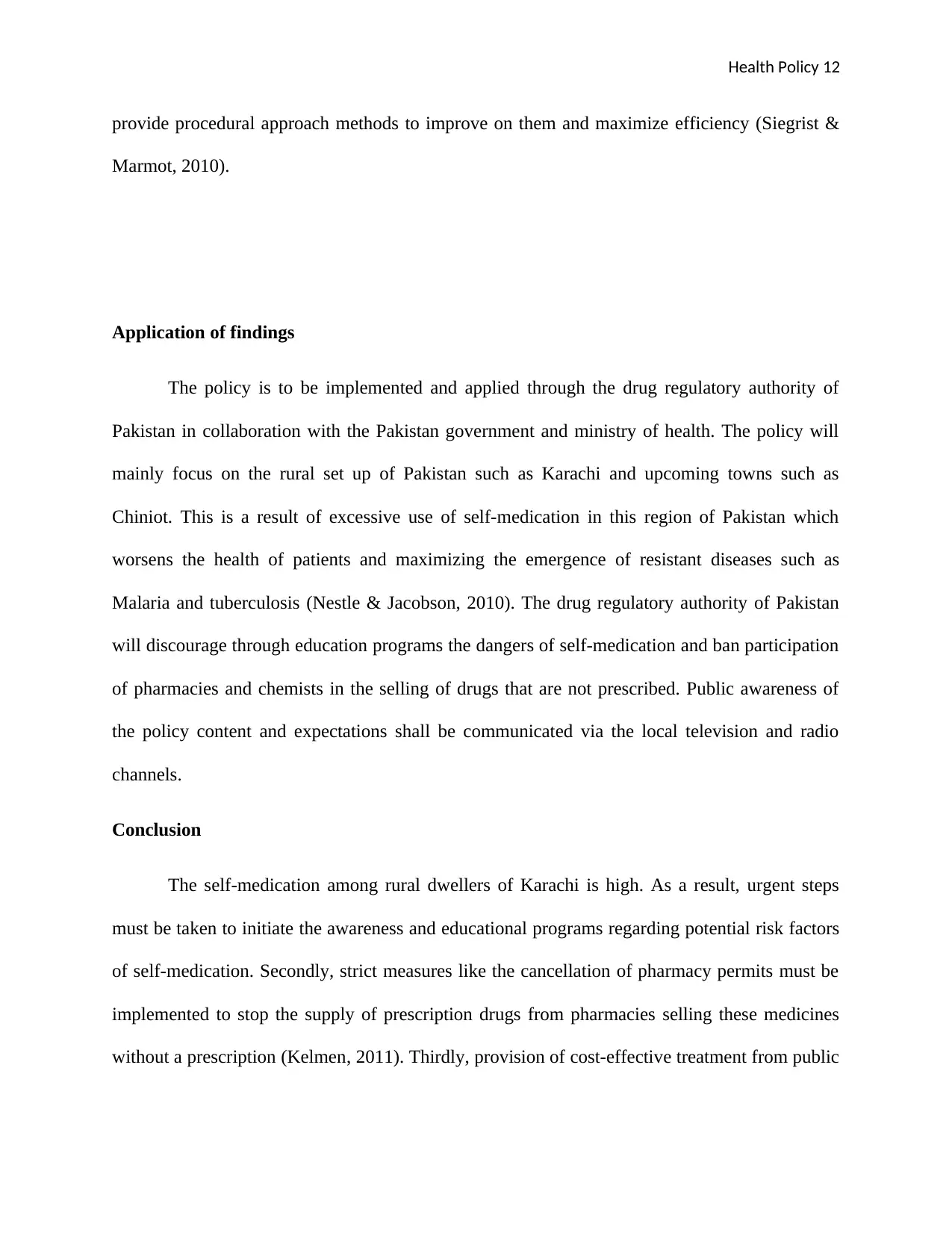
Health Policy 12
provide procedural approach methods to improve on them and maximize efficiency (Siegrist &
Marmot, 2010).
Application of findings
The policy is to be implemented and applied through the drug regulatory authority of
Pakistan in collaboration with the Pakistan government and ministry of health. The policy will
mainly focus on the rural set up of Pakistan such as Karachi and upcoming towns such as
Chiniot. This is a result of excessive use of self-medication in this region of Pakistan which
worsens the health of patients and maximizing the emergence of resistant diseases such as
Malaria and tuberculosis (Nestle & Jacobson, 2010). The drug regulatory authority of Pakistan
will discourage through education programs the dangers of self-medication and ban participation
of pharmacies and chemists in the selling of drugs that are not prescribed. Public awareness of
the policy content and expectations shall be communicated via the local television and radio
channels.
Conclusion
The self-medication among rural dwellers of Karachi is high. As a result, urgent steps
must be taken to initiate the awareness and educational programs regarding potential risk factors
of self-medication. Secondly, strict measures like the cancellation of pharmacy permits must be
implemented to stop the supply of prescription drugs from pharmacies selling these medicines
without a prescription (Kelmen, 2011). Thirdly, provision of cost-effective treatment from public
provide procedural approach methods to improve on them and maximize efficiency (Siegrist &
Marmot, 2010).
Application of findings
The policy is to be implemented and applied through the drug regulatory authority of
Pakistan in collaboration with the Pakistan government and ministry of health. The policy will
mainly focus on the rural set up of Pakistan such as Karachi and upcoming towns such as
Chiniot. This is a result of excessive use of self-medication in this region of Pakistan which
worsens the health of patients and maximizing the emergence of resistant diseases such as
Malaria and tuberculosis (Nestle & Jacobson, 2010). The drug regulatory authority of Pakistan
will discourage through education programs the dangers of self-medication and ban participation
of pharmacies and chemists in the selling of drugs that are not prescribed. Public awareness of
the policy content and expectations shall be communicated via the local television and radio
channels.
Conclusion
The self-medication among rural dwellers of Karachi is high. As a result, urgent steps
must be taken to initiate the awareness and educational programs regarding potential risk factors
of self-medication. Secondly, strict measures like the cancellation of pharmacy permits must be
implemented to stop the supply of prescription drugs from pharmacies selling these medicines
without a prescription (Kelmen, 2011). Thirdly, provision of cost-effective treatment from public
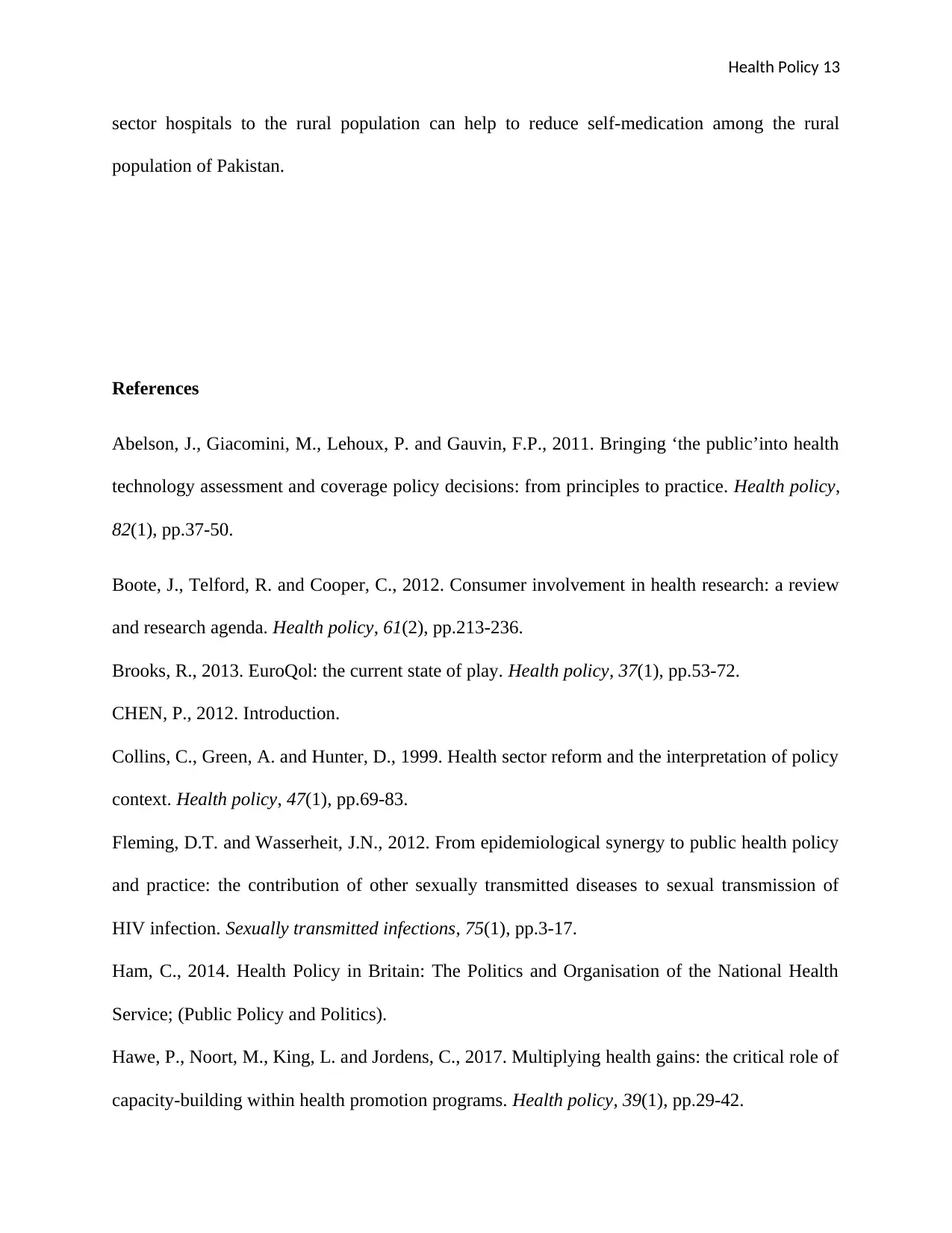
Health Policy 13
sector hospitals to the rural population can help to reduce self-medication among the rural
population of Pakistan.
References
Abelson, J., Giacomini, M., Lehoux, P. and Gauvin, F.P., 2011. Bringing ‘the public’into health
technology assessment and coverage policy decisions: from principles to practice. Health policy,
82(1), pp.37-50.
Boote, J., Telford, R. and Cooper, C., 2012. Consumer involvement in health research: a review
and research agenda. Health policy, 61(2), pp.213-236.
Brooks, R., 2013. EuroQol: the current state of play. Health policy, 37(1), pp.53-72.
CHEN, P., 2012. Introduction.
Collins, C., Green, A. and Hunter, D., 1999. Health sector reform and the interpretation of policy
context. Health policy, 47(1), pp.69-83.
Fleming, D.T. and Wasserheit, J.N., 2012. From epidemiological synergy to public health policy
and practice: the contribution of other sexually transmitted diseases to sexual transmission of
HIV infection. Sexually transmitted infections, 75(1), pp.3-17.
Ham, C., 2014. Health Policy in Britain: The Politics and Organisation of the National Health
Service; (Public Policy and Politics).
Hawe, P., Noort, M., King, L. and Jordens, C., 2017. Multiplying health gains: the critical role of
capacity-building within health promotion programs. Health policy, 39(1), pp.29-42.
sector hospitals to the rural population can help to reduce self-medication among the rural
population of Pakistan.
References
Abelson, J., Giacomini, M., Lehoux, P. and Gauvin, F.P., 2011. Bringing ‘the public’into health
technology assessment and coverage policy decisions: from principles to practice. Health policy,
82(1), pp.37-50.
Boote, J., Telford, R. and Cooper, C., 2012. Consumer involvement in health research: a review
and research agenda. Health policy, 61(2), pp.213-236.
Brooks, R., 2013. EuroQol: the current state of play. Health policy, 37(1), pp.53-72.
CHEN, P., 2012. Introduction.
Collins, C., Green, A. and Hunter, D., 1999. Health sector reform and the interpretation of policy
context. Health policy, 47(1), pp.69-83.
Fleming, D.T. and Wasserheit, J.N., 2012. From epidemiological synergy to public health policy
and practice: the contribution of other sexually transmitted diseases to sexual transmission of
HIV infection. Sexually transmitted infections, 75(1), pp.3-17.
Ham, C., 2014. Health Policy in Britain: The Politics and Organisation of the National Health
Service; (Public Policy and Politics).
Hawe, P., Noort, M., King, L. and Jordens, C., 2017. Multiplying health gains: the critical role of
capacity-building within health promotion programs. Health policy, 39(1), pp.29-42.
Paraphrase This Document
Need a fresh take? Get an instant paraphrase of this document with our AI Paraphraser
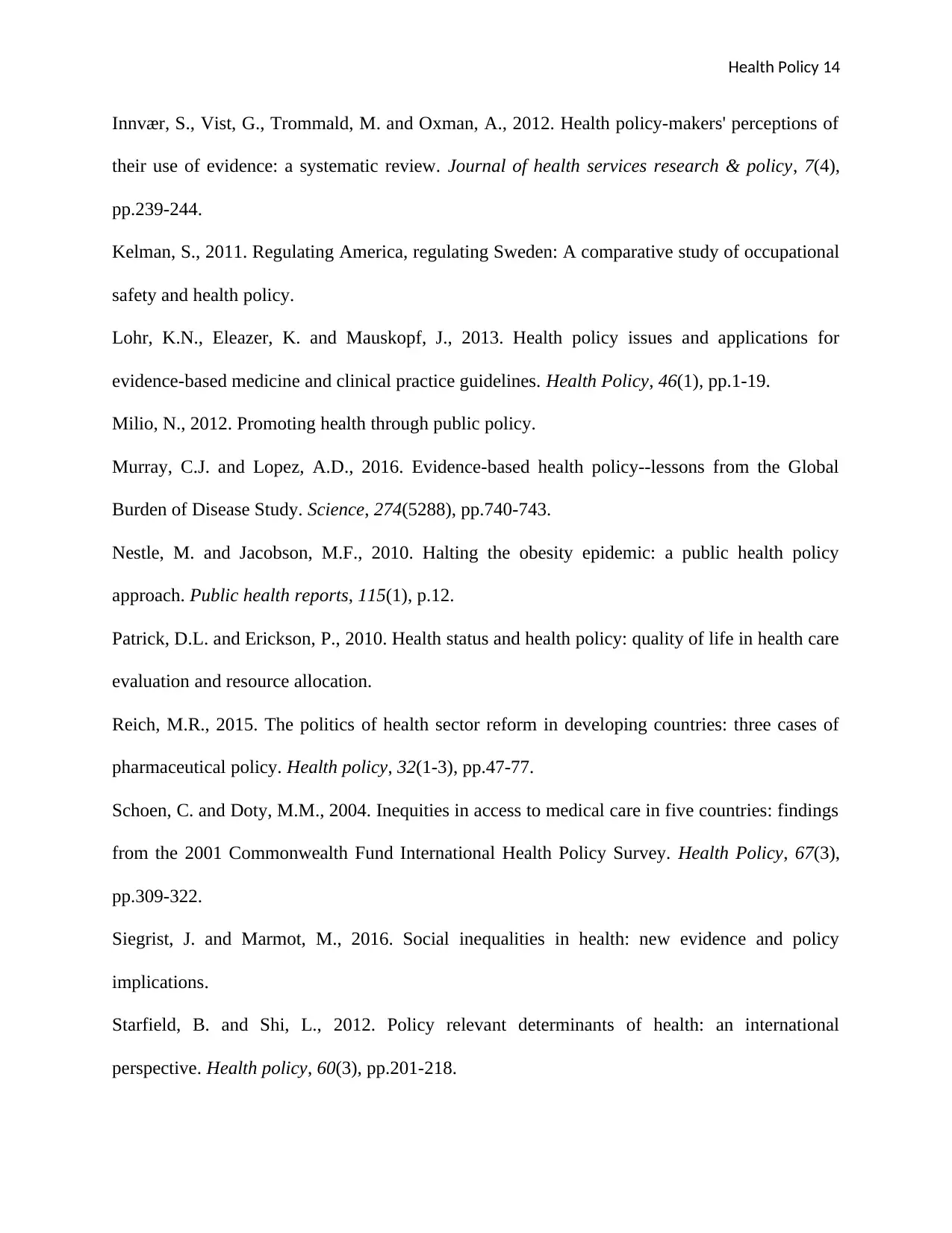
Health Policy 14
Innvær, S., Vist, G., Trommald, M. and Oxman, A., 2012. Health policy-makers' perceptions of
their use of evidence: a systematic review. Journal of health services research & policy, 7(4),
pp.239-244.
Kelman, S., 2011. Regulating America, regulating Sweden: A comparative study of occupational
safety and health policy.
Lohr, K.N., Eleazer, K. and Mauskopf, J., 2013. Health policy issues and applications for
evidence-based medicine and clinical practice guidelines. Health Policy, 46(1), pp.1-19.
Milio, N., 2012. Promoting health through public policy.
Murray, C.J. and Lopez, A.D., 2016. Evidence-based health policy--lessons from the Global
Burden of Disease Study. Science, 274(5288), pp.740-743.
Nestle, M. and Jacobson, M.F., 2010. Halting the obesity epidemic: a public health policy
approach. Public health reports, 115(1), p.12.
Patrick, D.L. and Erickson, P., 2010. Health status and health policy: quality of life in health care
evaluation and resource allocation.
Reich, M.R., 2015. The politics of health sector reform in developing countries: three cases of
pharmaceutical policy. Health policy, 32(1-3), pp.47-77.
Schoen, C. and Doty, M.M., 2004. Inequities in access to medical care in five countries: findings
from the 2001 Commonwealth Fund International Health Policy Survey. Health Policy, 67(3),
pp.309-322.
Siegrist, J. and Marmot, M., 2016. Social inequalities in health: new evidence and policy
implications.
Starfield, B. and Shi, L., 2012. Policy relevant determinants of health: an international
perspective. Health policy, 60(3), pp.201-218.
Innvær, S., Vist, G., Trommald, M. and Oxman, A., 2012. Health policy-makers' perceptions of
their use of evidence: a systematic review. Journal of health services research & policy, 7(4),
pp.239-244.
Kelman, S., 2011. Regulating America, regulating Sweden: A comparative study of occupational
safety and health policy.
Lohr, K.N., Eleazer, K. and Mauskopf, J., 2013. Health policy issues and applications for
evidence-based medicine and clinical practice guidelines. Health Policy, 46(1), pp.1-19.
Milio, N., 2012. Promoting health through public policy.
Murray, C.J. and Lopez, A.D., 2016. Evidence-based health policy--lessons from the Global
Burden of Disease Study. Science, 274(5288), pp.740-743.
Nestle, M. and Jacobson, M.F., 2010. Halting the obesity epidemic: a public health policy
approach. Public health reports, 115(1), p.12.
Patrick, D.L. and Erickson, P., 2010. Health status and health policy: quality of life in health care
evaluation and resource allocation.
Reich, M.R., 2015. The politics of health sector reform in developing countries: three cases of
pharmaceutical policy. Health policy, 32(1-3), pp.47-77.
Schoen, C. and Doty, M.M., 2004. Inequities in access to medical care in five countries: findings
from the 2001 Commonwealth Fund International Health Policy Survey. Health Policy, 67(3),
pp.309-322.
Siegrist, J. and Marmot, M., 2016. Social inequalities in health: new evidence and policy
implications.
Starfield, B. and Shi, L., 2012. Policy relevant determinants of health: an international
perspective. Health policy, 60(3), pp.201-218.
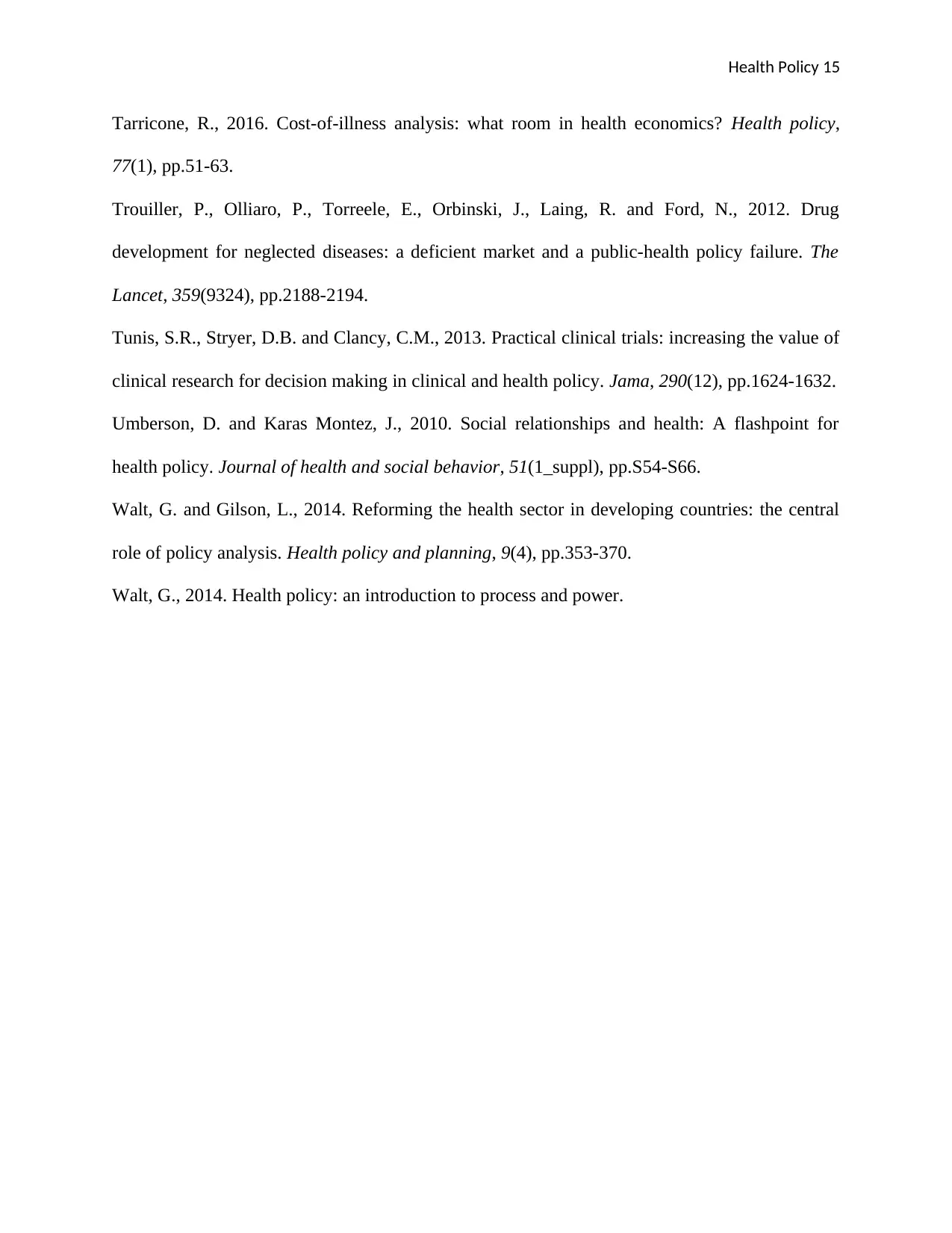
Health Policy 15
Tarricone, R., 2016. Cost-of-illness analysis: what room in health economics? Health policy,
77(1), pp.51-63.
Trouiller, P., Olliaro, P., Torreele, E., Orbinski, J., Laing, R. and Ford, N., 2012. Drug
development for neglected diseases: a deficient market and a public-health policy failure. The
Lancet, 359(9324), pp.2188-2194.
Tunis, S.R., Stryer, D.B. and Clancy, C.M., 2013. Practical clinical trials: increasing the value of
clinical research for decision making in clinical and health policy. Jama, 290(12), pp.1624-1632.
Umberson, D. and Karas Montez, J., 2010. Social relationships and health: A flashpoint for
health policy. Journal of health and social behavior, 51(1_suppl), pp.S54-S66.
Walt, G. and Gilson, L., 2014. Reforming the health sector in developing countries: the central
role of policy analysis. Health policy and planning, 9(4), pp.353-370.
Walt, G., 2014. Health policy: an introduction to process and power.
Tarricone, R., 2016. Cost-of-illness analysis: what room in health economics? Health policy,
77(1), pp.51-63.
Trouiller, P., Olliaro, P., Torreele, E., Orbinski, J., Laing, R. and Ford, N., 2012. Drug
development for neglected diseases: a deficient market and a public-health policy failure. The
Lancet, 359(9324), pp.2188-2194.
Tunis, S.R., Stryer, D.B. and Clancy, C.M., 2013. Practical clinical trials: increasing the value of
clinical research for decision making in clinical and health policy. Jama, 290(12), pp.1624-1632.
Umberson, D. and Karas Montez, J., 2010. Social relationships and health: A flashpoint for
health policy. Journal of health and social behavior, 51(1_suppl), pp.S54-S66.
Walt, G. and Gilson, L., 2014. Reforming the health sector in developing countries: the central
role of policy analysis. Health policy and planning, 9(4), pp.353-370.
Walt, G., 2014. Health policy: an introduction to process and power.
1 out of 15
Related Documents
Your All-in-One AI-Powered Toolkit for Academic Success.
+13062052269
info@desklib.com
Available 24*7 on WhatsApp / Email
![[object Object]](/_next/static/media/star-bottom.7253800d.svg)
Unlock your academic potential
© 2024 | Zucol Services PVT LTD | All rights reserved.




